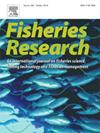Gender differences in participation rate, socioeconomic profile, recreational motivation, and wildlife-related value orientation among recreational fishers in Spain
IF 2.3
2区 农林科学
Q2 FISHERIES
引用次数: 0
Abstract
We analyse gender differences in recreational fisheries, using randomly collected data from Spain as a case study. Specifically, we contrast the participation rate, socioeconomic profile, self-determined motivations, and two wildlife-related value orientations (WVOs) among active (fished in the last 12 months) and lapsed (not fished in the last 12 months and without an intent to do so in the future) females and males participating in Spanish recreational fisheries, assessed via a nationwide telephone survey. Active participation rates in recreational fishing were significantly greater among males (21.5 % of the male population) than among females (11.7 % of the female population). Similar differences were also observed for lapsed participants. Active female recreational fishers were, on average, significantly younger (average 37 years) than their male counterparts (45 years), but other socioeconomic variables, such as residency in urban/rural settlements, income, or educational degree, did not differ. While the socioeconomic profile between active and lapsed male participants did not vary strongly, lapsed female participants in recreational fishing were older than active female participants, and had significantly lower income and degree of education. Female participants attributed significantly greater importance to engage with family than males as a motivation to recreate. Females also expressed greater importance to motives related to learning, discovering something new, and reflecting on one's identity and past good times than males. While the motivations between active and lapsed females were largely similar, the motivations between active and lapsed male participants were substantially different: active male recreational fishers placed significantly greater importance on taking risks, testing equipment, competing with others and teaching others than lapsed males. The WVOs of female and male participants in recreational fisheries were largely similar, but in lapsed fishers the mutualism score was significantly greater in females than males. Our study confirms the finding that the participation rate in recreational fishing is lower in females compared to males, and that males and females who made the decision to become active recreational fisheries share many motivations and values related to the use of wildlife and fish. That said, active female recreational fishers in Spain see fishing as a stronger contributor to family-related recreation than men.
西班牙休闲渔民参与率、社会经济状况、休闲动机及野生动物相关价值取向的性别差异
我们分析了休闲渔业的性别差异,使用从西班牙随机收集的数据作为案例研究。具体来说,我们对比了参与西班牙休闲渔业的女性和男性的参与率、社会经济状况、自主动机和两种与野生动物相关的价值取向(WVOs),通过全国电话调查进行评估。这些女性和男性活跃(过去12个月捕捞)和消失(过去12个月未捕捞且未来没有意图捕捞)。男性积极参与休闲钓鱼的比例(占男性人口的21.5% %)明显高于女性(占女性人口的11.7% %)。在失败的参与者中也观察到类似的差异。平均而言,活跃的女性休闲钓鱼者(平均37岁)明显比男性同行(45岁)年轻,但其他社会经济变量,如城市/农村定居点的居住,收入或教育程度,没有差异。虽然活跃和不活跃的男性参与者之间的社会经济状况差异不大,但休闲钓鱼中不活跃的女性参与者比活跃的女性参与者年龄大,收入和受教育程度明显较低。女性参与者认为,与男性相比,与家人在一起是娱乐的重要动力。女性也比男性更重视与学习、发现新事物、反思自己的身份和过去的美好时光有关的动机。虽然活跃和不活跃的女性参与者的动机大致相似,但活跃和不活跃的男性参与者的动机却有很大不同:活跃的男性休闲钓鱼者比不活跃的男性更重视冒险、测试设备、与他人竞争和教导他人。在休闲渔业中,女性和男性参与者的互惠得分基本相似,但在失业渔民中,女性的互惠得分显著高于男性。我们的研究证实了这一发现,即女性的休闲捕鱼参与率比男性低,而且决定成为活跃的休闲渔业的男性和女性在利用野生动物和鱼类方面有许多共同的动机和价值观。也就是说,在西班牙,活跃的女性休闲渔民比男性更看重钓鱼对家庭娱乐的贡献。
本文章由计算机程序翻译,如有差异,请以英文原文为准。
求助全文
约1分钟内获得全文
求助全文
来源期刊

Fisheries Research
农林科学-渔业
CiteScore
4.50
自引率
16.70%
发文量
294
审稿时长
15 weeks
期刊介绍:
This journal provides an international forum for the publication of papers in the areas of fisheries science, fishing technology, fisheries management and relevant socio-economics. The scope covers fisheries in salt, brackish and freshwater systems, and all aspects of associated ecology, environmental aspects of fisheries, and economics. Both theoretical and practical papers are acceptable, including laboratory and field experimental studies relevant to fisheries. Papers on the conservation of exploitable living resources are welcome. Review and Viewpoint articles are also published. As the specified areas inevitably impinge on and interrelate with each other, the approach of the journal is multidisciplinary, and authors are encouraged to emphasise the relevance of their own work to that of other disciplines. The journal is intended for fisheries scientists, biological oceanographers, gear technologists, economists, managers, administrators, policy makers and legislators.
 求助内容:
求助内容: 应助结果提醒方式:
应助结果提醒方式:


